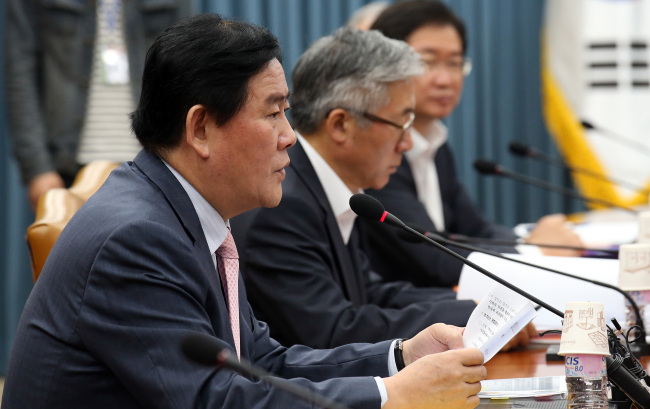Economic policymakers have decided to increase funding to companies that introduce the wage peak system as part of detailed measures to promote employment for the elderly.
Currently, companies that adopt the system receive 8.4 million won ($8,150) per year per worker over age 50 if the company employs the worker until age 60.
The annual state budget allotment will be expanded to 10.8 million won, the Finance Ministry and the Ministry of Employment and Labor said in a joint statement Wednesday. Finance Minister Choi Kyung-hwan added that the support would be granted for two years.
Currently, companies that adopt the system receive 8.4 million won ($8,150) per year per worker over age 50 if the company employs the worker until age 60.
The annual state budget allotment will be expanded to 10.8 million won, the Finance Ministry and the Ministry of Employment and Labor said in a joint statement Wednesday. Finance Minister Choi Kyung-hwan added that the support would be granted for two years.

The National Assembly passed a bill in April 2013 that would make it mandatory for the public sector and big businesses with 300 or more employees to extend the retirement age to 60 or older from 2016 and others, including small businesses, from 2017.
The wage peak system will extend the retirement age to 60 from the current ages that range between 53 and 58. The paycheck for elderly workers will be slashed by about 10 percent over their last several years at work.
In facilitating the implementation of the extended retirement age to 60 starting in 2016, a tripartite group of labor, business and the government had agreed that a successful wage peak system should help companies reduce the financial burden from the extended retirement age.
The government also decided to encourage businesses to consider placing a wage ceiling on highly paid executives so that they can hire more young employees or improve conditions for irregular workers.
As another key policy, the government said it would encourage industries to revamp their salary payment structures.
Currently, around 70 percent of local businesses whose payroll has more than 100 workers uses the “step payment” system in accordance with their working years.
In the coming additional measures, the Labor Ministry plans to unveil three payment structures, aimed at performance-based wages. Benchmarking some European models, it is considering introducing two more structures next year.
The Sept. 24 measures also included state-led life design programs for workers in their 50s to help them prepare for “reemployment” after retirement.
Employment-Labor Ministry officials expect the measures would pave the way for President Park Geun-hye’s campaign pledge to raise the nation’s employment rate to 70 percent by 2017 from the present 59 percent.
They forecast that the baby boomer generation, which refers to people born between 1955 and 1963 in Korea, will have greater opportunity for more work or reemployment. The number of baby boomers is estimated at 7.1 million, or 14.6 percent of the nation’s total population.
Advocates for employees called on the government to revise its policy, claiming that the number of “nonregular” elderly employees will ultimately increase under the Sept. 14 measures, which is not beneficial in terms of raising job security.
By Kim Yon-se (kys@heraldcorp.com)








![[Robert J. Fouser] Social attitudes toward language proficiency](http://res.heraldm.com/phpwas/restmb_idxmake.php?idx=644&simg=/content/image/2024/05/16/20240516050799_0.jpg&u=)

![[Graphic News] How much do Korean adults read?](http://res.heraldm.com/phpwas/restmb_idxmake.php?idx=644&simg=/content/image/2024/05/16/20240516050803_0.gif&u=)






![[Herald Interview] Byun Yo-han's 'unlikable' character is result of calculated acting](http://res.heraldm.com/phpwas/restmb_idxmake.php?idx=652&simg=/content/image/2024/05/16/20240516050855_0.jpg&u=)
